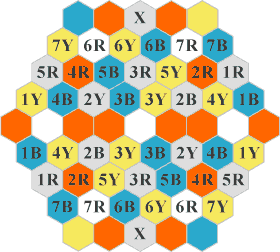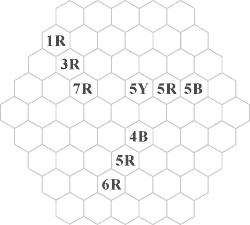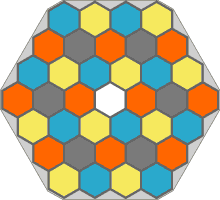-
Hexagonal playing cards are in essence identical to round cards which are known in India as traditional playing cards in India have round forms. Hence, it is possible to consider the offered game design as the Indian playing cards which are adapted for games on hexagonal game boards. Provided that in the offered game design there is different quantities of colors (suits) and values, and traditional playing cards in India have four suits.
-
| Tree-color cards. Deck 1st.
Tree-color cards.
Tree-color game board.
|
Description of the game design.
Three-color hexagonal playing cards are a version of this board
game in which two decks of playing cards have three suits that
corresponds with red and yellow and blue colors, and also playing cards
have values from 1 up to 10 on a face sheet. Total
in each deck there are 30 playing cards. Images of three-color hexagonal playing cards and three-color game board can be taken in the PDF file which is adjusted for printing on any usual printer in format A4. Namely images in the PDF file are divided into parts with which it is possible to print on a paper in format A4, and then it is possible to stick together parts and to make the game board and decks of playing cards.
The shown hexagonal board games can be considered as idea or prototypes
for online gaming in the Internet, namely as ideas of computer software
programs which allow to play cards on game portals and servers of world
wide web, or as prototypes of computer software games which are intended
for personal PC systems or tablet iPads and mobile iPhones. |
Preliminary playing cards have on the board in initial game positions, or shuffle and randomize in initial game positions. Variants of positions can be different, and in particular it is possible to offer game positions which are shown in figure where cards with values from 1 up to 7 are taken from each deck, and all 21 playing cards are taken from each deck.
 |
Each player possesses cards of own deck, namely decks
have on opposite parties of the game board. Playing cards have on the board openly, that is players can see opponent's cards, or there can be variants of games in which cards have on the board as closed and open during game. Players by turns move own playing cards on cells of the game board, and players can beat cards of the opponent according to colors and values as in traditional gaming, and also applying rules according to which cards become trump in cells of corresponding colors (suits). The purposes and problems of games can be different. For example, it is possible to apply a rule according to which players win if have moved any own card to a dark cell in rear of opponent's playing cards. Namely the problem of game can consist in moving playing cards on test cells which are noted in figure by daggers. |
Or game rules can consist in formation of card combinations. Namely in this case players should move cards on cells and can remove playing cards of the opponent from the board if combinations are formed. In particular combinations are cards of identical values or identical colors or sequences of increasing or decreasing values in the event that cards are located in a row. For example, in figure card combinations are shown.
 |
1R 3R 7R (unit of red - three of red - seven of red) -
combination of cards of identical colors. 5Y 5R 5B (five of yellow - five of red - five of blue) - combination of cards of identical values. 4B 5R 6R (four of blue - five of red - six of red) - combination of cards of consecutive values. |
Rules of puzzles too can be different.
For example, it is possible to reshuffle preliminary playing cards of two decks
and to arrange in 60 cells of the game board, and one central cell to leave
empty, and then it is possible to move cards. The first course should follow on
the empty cell, and subsequently playing cards can be moved on empty cells which
are released during decision of a puzzle (patience).
The condition of such puzzle consists that cards can be moved if as a result
there are combinations in which there are 3 cards, and the problem of this
puzzle consists that it is necessary to form a combination which are formed of 9 cards.
 |
Besides for to realization of games and puzzles it is
possible to apply the hexagonal game board which has 37 cells, but 7
cells are dark and white and 37-7=30 cells have colors namely 30 cells
are red or blue or yellow, that is comparable to quantity of three-color
playing cards in one deck. Very diverse rules of gaming and puzzles can be thought up according to configuration of 37 hexagonal cells of this game board, and by means of 30 playing cards of one deck. |
-
Various rules can be similar to rules of games and puzzles which are described on pages of other website about card gaming, but which are intended for playing cards and game boards which have traditional rectangular forms.